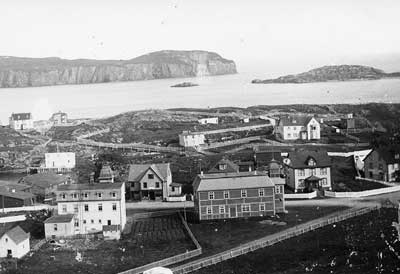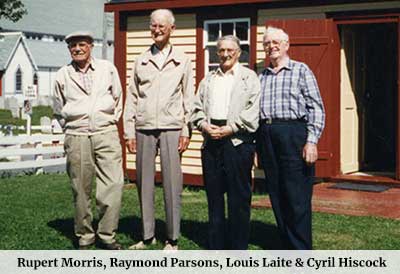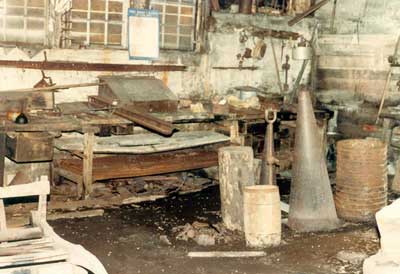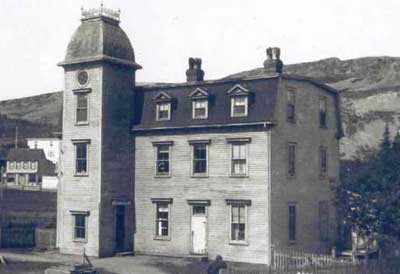
To preserve, present, and promote the built and cultural heritage of Trinity and area.
The Trinity Historical Society evolved from a committee elected at a public meeting in Trinity on February 7, 1964. Elected members were Raymond M. Parsons, Harry Chaulk, Peter Coleridge, Calvert Goldsworthy, Ambrose Clarke and Rupert Morris. Walter G. C. White, residing for the winter in St. John’s, declined membership on this committee because of ill health but collected relevant material and became the contact for the committee with government agencies in the city. Mr. White and Rev. Edward Hunt were named honorary members.
The original committee was called the Trinity Historic Sites Committee. Its aim was to develop Fort (Admiral’s) Point, and Ryder’s and Gun Hills as National Historic Sites. The immediate areas would be established as National Historic Parks. The group also wished to reconstruct and pave the road from Dunfield to the Fort and to construct and pave a road around or over Gun Hill and Ryder’s Hill. While these ideas held intrinsic value, they would also bring much needed employment to an area in a state of economic decline. A 1967 target date was established for completion. The committee also began collecting information from local, provincial, national and international sources to document Trinity’s historic resources, heritage and history.
Despite numerous submissions to agencies, and site visits from officials, and platitudes from federal and provincial government departments, little was accomplished regarding the main objective of the Committee. Nevertheless, a large collection of material was assembled from many generous donors.
By 1966, in time for a province-wide Come Home Year, the committee had collected more than enough material to establish an exhibit of archival material including charts, diagrams of local roads, diaries, account books, photographs and drawings of the town and ships, flags and histories. Prepared by members of the Historic Sites Committee and the Come Home Year Committee, the exhibit was held at the Court House. Not only was it well received but the spectrum and volume of material collected surprised many in attendance.
 Following the Come Home Year celebrations, members of these committees decided to form a permanent museum and archives. On November 21, 1966, the Trinity Historical Society was established with the following members present: Rupert Morris, President; Louis Laite, Secretary-Treasurer; Walter White, Corresponding Secretary; and members Raymond M. Parsons, Peter Coleridge and Calvert Goldsworthy. At the next meeting, N. Stuart Fraser, Cyril Hiscock, Norman Macfie and Clarence B. Dewling were added to the membership. By 1968, the membership had expanded to include Rev. G. W. Etheridge, Ada L. Green, Margaret Parsons, Stella E. White, Marie Eriksen, Mary M. White and Ross Batson. All those named are considered to be founding members.
Following the Come Home Year celebrations, members of these committees decided to form a permanent museum and archives. On November 21, 1966, the Trinity Historical Society was established with the following members present: Rupert Morris, President; Louis Laite, Secretary-Treasurer; Walter White, Corresponding Secretary; and members Raymond M. Parsons, Peter Coleridge and Calvert Goldsworthy. At the next meeting, N. Stuart Fraser, Cyril Hiscock, Norman Macfie and Clarence B. Dewling were added to the membership. By 1968, the membership had expanded to include Rev. G. W. Etheridge, Ada L. Green, Margaret Parsons, Stella E. White, Marie Eriksen, Mary M. White and Ross Batson. All those named are considered to be founding members.
By November 26, 1971, the date on which Trinity Historical Society was incorporated as a not-for-profit organization, it had acquired additional property next to the museum and had greatly expanded both its collection of artifacts for the museum and archival material. The Society and its activities had received provincial and national recognition, and correspondence was being exchanged worldwide.
In 1978, a $1.5 million project was announced stating that Trinity was to become a “Heritage Village.” However, the extent of federal and provincial funding was insufficient to cover the full cost of the undertaking. The project was renamed “The Trinity Restoration Project.” Many older buildings were refurbished on their exterior including the Parish Hall, the Court House, and the Anglican and Roman Catholic Churches and the Mortuary Chapel. Private dwellings were supplied with wooden roof shingles. The Wesleyan/Methodist School (SUF Hall) was acquired and refurbished. A start was made on reconstructing the Garland Shop (Ryan’s). The Hiscock House was acquired and restored to the 1910 period. A private dwelling was purchased and later moved to the Historic Site, remodelled and opened as the Interpretation Centre. Contracts were let for research on various aspects of Trinity’s history.
Once the Trinity Restoration Project was underway, the primary task of the Trinity Historical Society was to maintain and operate the museum and archives and to provide advice to researchers as required. The Society was also actively engaged in planning future projects, especially those dealing with the expansion of its facilities. Both the museum and archives were overflowing with material. The restoration or reconstruction of historic sites and buildings, particularly the Fort, the Lester-Garland House.

In 1990, the Society was particularly pleased to receive the donation of the Green Family Forge from Ada L. Nemec. Although the Green family had operated a blacksmith business in Trinity prior to 1750, the present building was built in the 1890s and functioned until 1955. Along with the building came tools of the trade and about 1500 artifacts. The building has been refurbished and the artifacts treated and preserved. It opened to the public in 1991 and in 1999 became operational once again with a blacksmith on-site.
The Society also played a large role in the formation of two fundraising bodies in 1993: the Trinity Trust-Canada and the Trinity Trust-England. These funds would be directed toward rebuilding of the Lester-Garland House. Members of the Society had originally tried to stop the destruction of the home in the 1960s when the last property owners took it down but the interest was not there to preserve the original structure at that time. The members did; however, have the foresight to take measurements and photographs of the exterior and interior of the building as well as some items such as a door, window and some trim work, which made the reconstruction process easier. Construction began in September 1996 and was completed for a June 25, 1997 opening. The building is now used to interpret the history of the Lester-Garland family and trade and as a learning centre.

Also in 1996, the Society purchased the Court House, Gaol and General Building from the Government of Newfoundland and Labrador and, during 1997, opened an office and archives. Most of the archival textual materials (including books, journals, newspapers, ledgers, maps and charts and office files etc.) and photographic materials not on display elsewhere have been relocated to the Archives. This material was arranged, catalogued and organized during the summers of 1997 and 1998. A finding aid was created for the material. In 2001, the office and archive materials moved to the Lester-Garland House.
The Society continues to be active in community economic development while holding true to its original mandate to preserve, present and promote the history of the Trinity Area. In 2004, Trinity Historical Society celebrated its 40th anniversary with an exhibit in the Lester-Garland House. During 2006, the Society’s first virtual exhibit was launched www.newfoundlandshipwrecks.com and an Oral History Project was completed in the communities of Kerley’s Harbour, White Point, George’s Cove, New Bonaventure, Cat Cove, Old Bonaventure and Whale Cove.
In 2007 the Society took over the operation of the Lester-Garland House from the Trinity Trust and launched its second virtual exhibit www.newfoundlandandthesomme.com. It has since launched two more virtual exhibits, www.newfoundlandshipbuilding.com and www.trinitymerchants.com.
In 2008, to expand its living history interpretation of the trades, the Society opened the Cooperage. The Society also began some interior renovation work at the Trinity Museum and an updating of its collection management policies and procedures, which involved cleaning, photographing and entering into an electronic collections management system.
Major renovation work was completed in 2010 to the Court House, Gaol and General Building, which included reconstruction of the tower and installation of the original clock.
The Society remains active in a variety of areas and is considered a leader in heritage and tourism related activities. The organization has had a vibrant past and its future is bright and promising.
